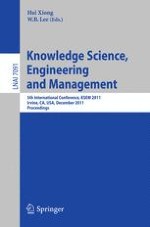2011 | Book
Knowledge Science, Engineering and Management
5th International Conference, KSEM 2011, Irvine, CA, USA, December 12-14, 2011. Proceedings
Editors: Hui Xiong, W. B. Lee
Publisher: Springer Berlin Heidelberg
Book Series : Lecture Notes in Computer Science
